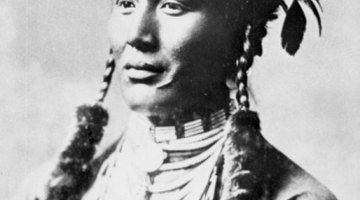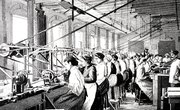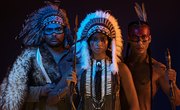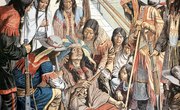Men and women among the Comanche Indians held distinct roles. The bands of Comanche that roamed the Great Plains area of the United States in the 19th century adhered to a traditional division of labor, which left women in charge of work related to home and family, while men hunted and fought. Additionally, high-ranking men engaged in trade with Europeans, Mexicans and Americans, often to sell back kidnapped relatives and dignitaries.
Men - Hunting and Herding
Young men tended the tribe's flocks and trained for manhood. Coming-of-age meant the responsibility of fishing and hunting elk, buffalo and other game. After the Comanche acquired horses, they expected their young men to learn horse-riding skills, which could be used both for tracking animals and herding. The Comanche were considered the best horsemen among the Plains Indians.
Men - Warfare
The Comanche used their horses most notably for warfare. Their young men trained to use bows and arrows and spears and shields made from buffalo hide. If rifles were available, the arts of marksmanship had to be learned, as well. Horse-mounted Comanche men went on raids that extended as far south as the jungles of Mexico. On these raids, which might last for months, men occupied themselves with acquiring the transportable goods of whichever people they fought.
Men - Trade
Among the transportable goods the Comanche acquired on these raids were members of other tribes or citizens from Mexico or the United States. High-ranking Comanche men accompanied the armed groups that led these captives to meeting places with relatives and/or diplomats and exchanged them for money or other goods. These high-ranking men were from among the elite leadership of each tribe. A man could rise to such rank by exhibiting prowess in combat.
Women - Gathering Food and Cooking
The Comanche were hunters and gatherers and, as was often the case with such cultures, women were in charge of the gathering. Since the Comanche were a polygamous society, one or more women might be attached to a single man and care for him by collecting nuts, berries and other wild vegetation near their camp. Women prepared meals for their men with the food they gathered and the meat brought home by hunters.
Women - The Home
Women were also responsible for the home, which was usually a tee pee made form hides and wood. They did not simply clean the home. Women had to actually build the tee pee, even if that meant carrying heavy wood and erecting the structure themselves. They were also charged with raising children. Men would take charge of older boys, but women raised the girls and prepared them for marriage and motherhood.
Related Articles
References
Writer Bio
Robert Paxton has been writing professionally since 2002 when he published his first novel. He has also published short stories and poems and writes ad copy for various websites. He graduated from the University of Arizona in 1995 with a bachelor's degree in creative writing. Paxton is a trained Montessori instructor who has taught at both the elementary and the secondary levels.











